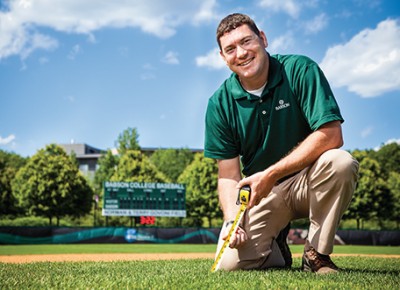
Photo: Pat Piasecki
Erik Shaw at Norman and Terry Govoni Field
When Erik Shaw looks over the pretty green of Babson’s baseball field, he thinks about his youth and the wonderful times he spent playing the game. He was a pitcher in high school. “It brings me back to my glory days,” says the grounds supervisor, who manages the maintenance of the Norman and Terry Govoni Field, named for the longtime assistant baseball coach and professor and his late wife, who was a big Beavers fan.
When Doug Pottle sees Govoni Field, he is struck first by how “gorgeous” it is. But then he focuses on the imperfections— the imperceptible dips and the edges that need a little tightening—that only someone who has worked the grounds of Babson for 19 years would notice. “You always want to do more,” says the athletic fields specialist. “Nothing is perfect.”
While Govoni may not be perfect, the field has a well-earned reputation as a fine place to play ball. A number of outside groups, including area high schools and colleges, clamor to play on it. The New England Ruffnecks, a program for dedicated teenage ballplayers, uses Govoni as its main home field. Back in 2007, the American Baseball Coaches Association commended the field with the group’s annual maintenance award.
To make a field look this good, though, takes work—work that is long and constant. Every week, Pottle and fellow groundskeeper Tim Donovan spend a combined 80 hours working on Govoni and the other athletic fields. About 25 hours of that is spent just mowing, Shaw says.
The toughest maintenance challenges come when the baseball season opens in the cold and wet of March. “It’s hard to meet expectations when Mother Nature doesn’t cooperate,” Shaw says. The clay infield retains a lot of water, and the early-spring chill can cause it to freeze at night. If the field is needed for an afternoon game, Pottle and Donovan first have to wait until the infield thaws. That might take until 11 a.m. or noon, which doesn’t leave much time before 1:30 p.m. batting practice. To then dry the infield, they perform a process called “nail dragging.” As the name suggests, it involves dragging a square mat with protruding nails over the clay to open it up to the air. Once that’s done, a clay-like drying agent is applied.
Clay remains a focus throughout the rest of the season. The spikes of players’ shoes wear out both the batter’s box and pitcher’s mound, so if the rough spots aren’t removed and new soil added and repacked, water can enter the clay and turn it hard like cement. “Clay is the most water-loving soil,” Shaw says. To smooth out the clay in the rest of the infield, a ride-on three-wheeler is used that pulls a groomer behind it. “It’s a rake on wheels,” Shaw says.
During the year, the field is aerated once and fertilized four times, and the infield is covered up anytime a big rain is forecast. Then there’s mowing, lots of mowing. Two mowers are used on the field: a 21-inch, walk-behind mower for the infield, and a ride-on, 80-inch mower for the outfield. The groundskeepers aim to cut the outfield grass down to 2 inches, and the infield, which is mowed before every game, down to an inch and a half. They vary the patterns they cut in the grass, but they don’t get too fancy. “We don’t have time to do artistic designs like they do at Fenway Park,” Shaw says.
The work may be never-ending, but it pays off when players and coaches express their appreciation. “When they come up to you and say, ‘Things look great today,’ that’s the reward for us,” Shaw says.—John Crawford
